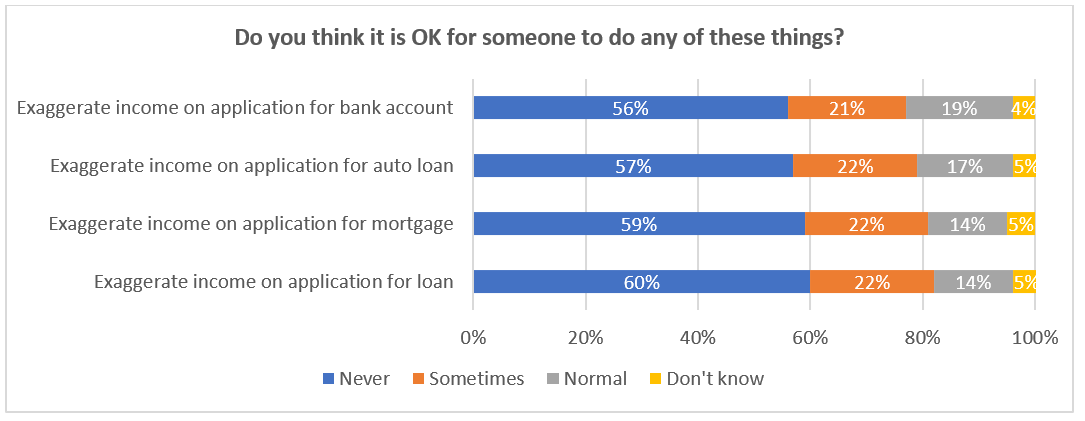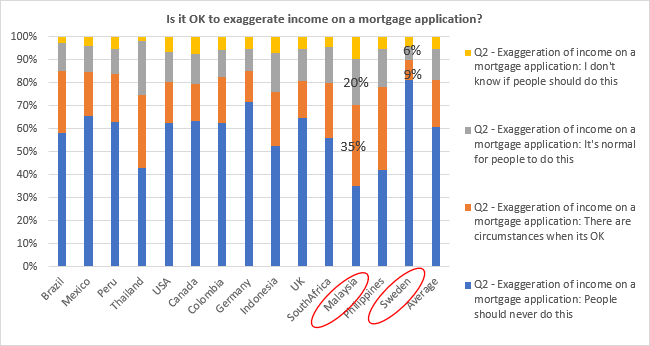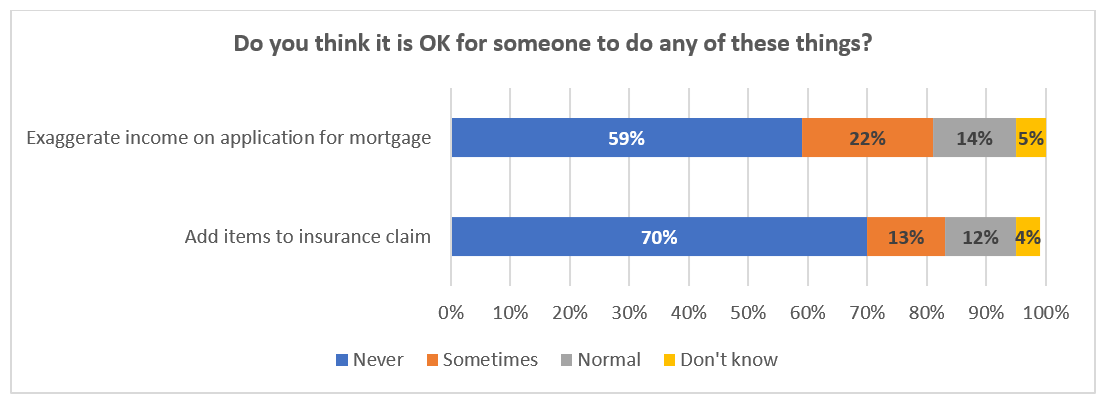First-Party Fraud Must Be Stopped Across the Customer Lifecycle
Financial institutions face first-party risks “inside the wire” - 14% of customers worldwide think it is normal to exaggerate income on a mortgage application

FICO’s 2022 global consumer survey on financial services and fraud produced some surprising results, but none more alarming than the 25% to 30% of financial institutions’ (FIs’) customers who think it is normal or OK in some cases to falsify income on an application for an account or loan (see chart). While those in the financial services industry would term this first-party fraud, it is evident that a significant minority of people don’t think of such behaviour as unacceptable.

While this percentage is not universal across all markets surveyed, even in Sweden where 81% of customers say it is never OK for someone to exaggerate income on a mortgage application (see chart), 9% of customers in Sweden believe it is OK in some circumstances and 6% feel it is normal.

In Malaysia, on the other hand, just 35% of customers say it is never OK to exaggerate income on a mortgage application, but 1 in 5 (20%) feel it is normal and more than a third (36%) believe it is permissible in some circumstances.
In short, the best a financial institution can hope for is that only one in six applicants believes it is normal or permissible to commit fraud by falsifying income data on a loan application.
This places a substantial burden on financial institution, because customers they trust, or who look legitimate on paper and with whom they may have an existing banking relationship, are highly susceptible to using that relationship as a path to commit fraud. Unlike synthetic identity fraud or third-party fraud, where the applicant is using a stolen or synthetic identity, it is a much trickier proposition to spot those who are applying in their own names and probably don’t even think of themselves as fraudsters.
Falsifying Insurance Claims Is More Taboo
Another data point demonstrates how customers view the commission of similar types of fraud differently. 70% of customers worldwide say it is never OK to add items falsely to an insurance claim, but only 61% say it is never OK to exaggerate income on a mortgage application (see chart). And while 12% of customers say it is normal to add false items to an insurance claim, which is less than any other category, 14% say it is normal to exaggerate income on a mortgage application.
It is possible that more customers perceive the consequences of falsifying income data on a mortgage application to be less severe than submitting fraudulent insurance claims, or that faking the loss of an item when reporting an actual theft is more difficult to get away with than faking income one has never earned.

In either case, a substantial portion of customers are susceptible to making poor decisions that result in first-party fraud. As institutions refine their customer experiences and use of data analytics to better understand customers and fraud risks, evaluating these risks throughout the customer lifecycle will continue to prove crucial to combat fraud in every phase of the relationship.
Diverse Data Analysis Is Needed
The key for financial institutions is to practice a form of continuous assurance whereby customer data from across the organization is brought together and utilized to create a complete picture of a customer which may indicate a circumstance, inaccuracy, or convergence of data that points to first-party fraud in some form.
That fraud may manifest in impersonation scams or in seemingly legitimate customers providing different answers to similar questions in different channels, even over time. Different income levels reported on different applications in the same time frame could reflect fraud, whereas over time they may reflect the waxing or waning of the job market.
Still, as customers’ personal financial circumstances change, they may become more or less likely to make questionable decisions and commit fraud, justified in their own mind as a permissible circumstance. While financial institutions see exaggeration of income by an applicant as a clear-cut case of fraud, the customer's intention isn’t to become a fraudster: they simply don’t equate their behavior with questionable or even criminal activity. This calls for ongoing analysis of customer behavior, in the context of both historical and third-party data, to evaluate risk and identify fraud in any form – including that perpetrated by existing customers.
Why This Matters Now
With the World Bank predicting growth will slump in 2022 and many countries facing a cost-of-living crisis, the stakes for financial institutions are becoming higher. Previous economic downturns have shown that fraud increases. The Association of Certified Fraud Examiners (ACFE) looked at the impact of the 2009 economic recession and reported that 55% of their members saw a slight or significant increase in the level of fraud and over 49% said that this was due to financial pressures on individuals.
The FICO survey shows that many people have a flexible attitude to committing first-party fraud that is often based on circumstances. The current economic downturn may tip people towards believing that their circumstances make such behaviour acceptable. In many cases customers may not equate lying on an application as fraud. Financial institutions that can spot it happening before credit is extended are not only protecting themselves but also their customers who may otherwise find themselves on an unintentional path to criminal behaviour.
How FICO Can Help You Fight Application Fraud
- Download the white paper on this survey
- Changing Face of Application Fraud Whitepaper: With new attack vectors, evolving customer expectations and data proliferation, is now the time for a new strategy?
- Combatting First-Party and Synthetic Identity Fraud: Five best practices you need now.
- Application Fraud – Hot topic Q&A: learn from Andy Pollock, our application fraud expert, about the impact of first-party, third-party and synthetic identity fraud.
Popular Posts

Business and IT Alignment is Critical to Your AI Success
These are the five pillars that can unite business and IT goals and convert artificial intelligence into measurable value — fast
Read more
It’s 2021. Do You Know What Your AI Is Doing?
New "State of Responsible AI" report from Corinium and FICO finds that most companies don’t—and are deploying artificial intelligence at significant risk
Read more
FICO® Score 10T Decisively Beats VantageScore 4.0 on Predictability
An analysis by FICO data scientists has found that FICO Score 10T significantly outperforms VantageScore 4.0 in mortgage origination predictive power.
Read moreTake the next step
Connect with FICO for answers to all your product and solution questions. Interested in becoming a business partner? Contact us to learn more. We look forward to hearing from you.
